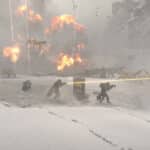Flick shots, snaps, switches, target acquisitions and so on all follow the same principle of quickly moving your crosshair from one place to another. But how exactly do you do that? And better yet, how is it done accurately? First off, let’s look at a few reasons as to why flick shots are so useful so we can better understand why they’re worth learning in the first place. Then i’ll cover exactly how they’re done, from in-game settings, to the hand and mouse movements needed. The first and simplest reason is to reduce downtime and improve our time to kill.
If you enjoy this content, consider subscribing to Struth Gaming’s YouTube channel!
Key Takeaways:
- Flick shots allow us to start doing damage as quickly as possible and hit evasive targets.
- Settings such as monitor refresh rate and sensitivity play a crucial role in flick shots.
- Flick shots can be executed in two forms: rebounds and dead stops.
- Be deliberate, calculated, and record your gameplay to improve your flick shot accuracy.
Why Are Flick Shots Useful?
Flick shots are crucial in reducing downtime and improving your time to kill in any game. Every moment you delay before firing at an enemy is time wasted, and they could be doing damage to you. Flick shots also help hit evasive targets that would otherwise be difficult to follow.
In-Game Settings for Flick Shots
To execute flick shots accurately, you need to optimize your in-game settings. Ensure your monitor is running at its highest refresh rate, set your in-game refresh rate to the highest available, play on fullscreen or fullscreen exclusive mode if possible, disable V-Sync, and lower your graphic settings to improve your framerate. Mouse sensitivity is also crucial for flick shots, and a sensitivity between 25 and 50cm/360 is recommended for learning.
Types of Flick Shots
Flick shots come in two forms: rebounds and dead stops. Rebounded flick shots are more forgiving in terms of accuracy, while dead stop flick shots are used for target acquisition and more advanced aimers. Rebounding helps clear up your vision by getting your gun model, crosshair, and other elements away from the target. However, it’s important not to overdo rebounds, especially for cross-screen flicks, as they are more challenging to land.
Executing Flick Shots
Physically performing a flick shot requires specific hand and mouse movements. The speed of the flick is crucial, as being too slow or too fast can result in miss-timed shots. Rebounding is a technique that helps deal with the inertia of the movement, while dead stop flick shots allow for better judgment of distance and enemy movement. Holding your arm above the mousepad and practicing in paint can help you visualize and improve your flick shot execution.
Improving Flick Shots
To improve your flick shots, remember to be deliberate and calculated with each shot. Choose a specific target and take a moment to read their movement before firing. Breaking down the flick shot into its components can also help improve accuracy. Recording your gameplay and analyzing it frame by frame can provide insights into what is causing your flick shots to miss. Lastly, remember that not every shot needs to be a flick shot, and focusing on neat, fast, and calculated crosshair movements can lead to better overall aim.




